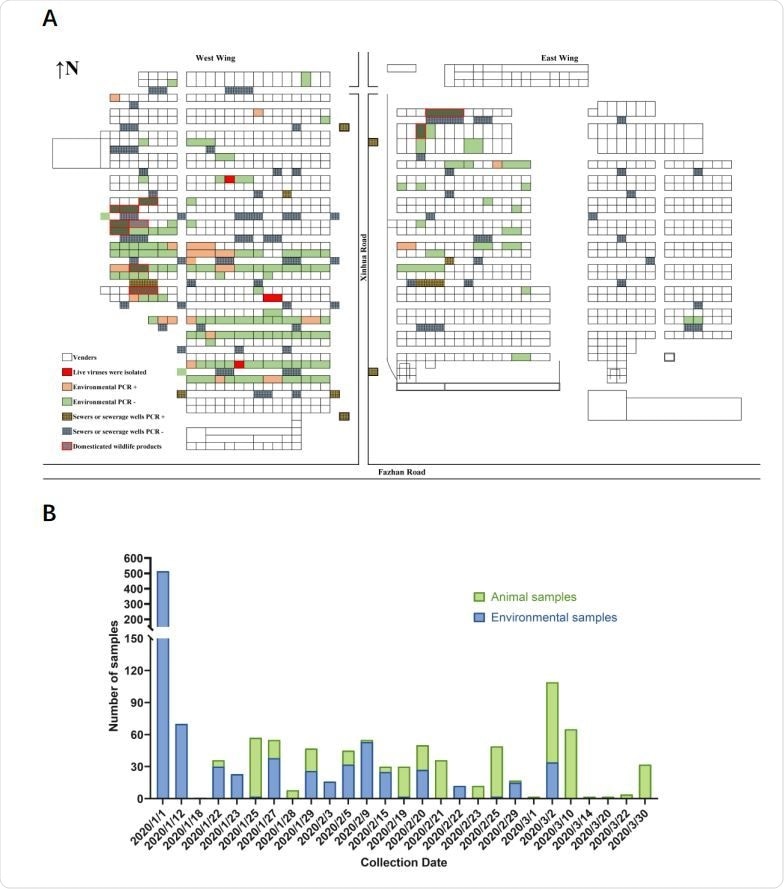Infection with the severe acute respiratory syndrome coronavirus 2 (SARS-CoV-2), the causal agent of the ongoing coronavirus disease 2019 (COVID-19) pandemic, can lead to various clinical outcomes ranging from asymptomatic cases to severe infections and even death.
A majority of early SARS-CoV-2 infections have been linked to the Huanan Seafood Market (HSM) in Wuhan, China, where various animal meats and exotic seafood were available for purchase. Although HSM is assumed to be the source of the COVID-19 pandemic, it is possible that an individual introduced SARS-CoV-2 into the market through human-to-human transmission, as early COVID-19 cases could not be epidemiologically linked to the market.

Study: Surveillance of SARS-CoV-2 in the environment and animal samples of the Huanan Seafood Market. Image Credit: sleepingpanda / Shutterstock.com

 This news article was a review of a preliminary scientific report that had not undergone peer-review at the time of publication. Since its initial publication, the scientific report has now been peer reviewed and accepted for publication in a Scientific Journal. Links to the preliminary and peer-reviewed reports are available in the Sources section at the bottom of this article. View Sources
This news article was a review of a preliminary scientific report that had not undergone peer-review at the time of publication. Since its initial publication, the scientific report has now been peer reviewed and accepted for publication in a Scientific Journal. Links to the preliminary and peer-reviewed reports are available in the Sources section at the bottom of this article. View Sources
Background
Several studies have indicated that some of the suspected SARS-CoV-2 positive samples were detected even earlier than the first case in Wuhan. In fact, these reports indicate that SARS-CoV-2 might have been in circulation in other regions.
Although bats are believed to be the original source of SARS-CoV-2, it remains unclear whether an intermediate animal host enabled the virus spillover between bats and humans. To this end, one study has indicated that pangolins harbored a highly similar receptor binding domain as SARS-CoV-2; however, there remains limited evidence to confirm that pangolins were definitively the intermediate host for this virus.
Researchers have also previously documented the animal species in HSM between May 2017 and November 2019, which demonstrated that neither bats nor pangolins were traded during this period. Thus, further questions remain as to whether HSM was the original source of SARS-CoV-2.
About the study
A new study published on the Research Square* preprint server describes the surveillance of SARS-CoV-2 within the HSM. HSM is separated into an eastern and western zone, wherein seafood and animals are mainly sold in the western zone, while livestock and meat are sold in the eastern zone.
According to the sales record, during late December 2019, animals or animal products were sold in ten animal stalls. Some of the animals that were sold included Sika deer, avian species including chickens, ducks, pheasants, and doves, as well as snakes, badgers, rabbits, bamboo rats, porcupines, hedgehogs, and crocodiles, to name a few.
In early January 2020, the markets were closed due to the rapid spread of SARS-CoV-2. During this time, the Chinese Centers for Disease Control and Prevention (China CDC) dispatched an epidemiological team, which collected environmental and animal samples from HSM.
Study findings
The scientists analyzed a total of 1,380 samples from the environment and animals within the market in early 2020 to detect the presence of SARS-CoV-2 through the use of reverse-transcriptase qualitative polymerase chain reaction (RT-qPCR) assay. Overall, the nucleic acid test (NAT) revealed that 7.9% of samples were SARS-CoV-2 positive. Additionally, researchers estimated the cycle threshold (Ct) values of real-time polymerase chain reaction (PCR) which ranged from 23.9 to 41.7.
Among the environmental samples, which were collected from in and around the market, seventy-three samples tested positive for SARS-CoV-2. Three live viruses were also successfully isolated from these samples with Ct values less than 30 in the NAT.
High-throughput sequencing on the Miseq platform was used to obtain seven complete SARS-CoV-2 genome sequences. To this end, the viruses isolated from the HSM shared high similarities with human isolate HCoV/Wuhan/IVDC-HB-01. Interestingly, SARS-CoV-2 was not detected in any of the animal samples, which covered around eighteen species sold in the market.
The activities of merchants were also analyzed against the NAT results of the environmental samples. The sampling covered 19.8% of the vendors in the market, with a majority of SARS-CoV-2 positive samples linked to vendors from the west zone.

The distribution of the positive environmental samples in Huanan Seafood Market. A. As the place of the early cluster of COVID-19 patients, the Huanan Seafood Market is separated into eastern and western zones with the Xinhua Rd. between them. To detect for the presence of SARS-CoV-2 RNA, reverse transcription, quantitative polymerase chain reaction (RT-qPCR) was performed. The locations of the positive samples were marked in the map of the market within orange, while the location of the samples that the live viruses were isolated from were labeled with red. The map also shows locations of stalls where domesticated wildlife products were sold. B. Timeline of environmental and animal samples collected within and around Huanan Seafood Market.
Although some vendors sold more than one type of animal product, no significant differences were observed between different vendors, including cold-chain products. This indicates the possibility that SARS-CoV-2 was circulating in the HSM, particularly in the western zone, and ultimately led to the extensive distribution of this virus within the market. Moreover, the spread of SARS-CoV-2 might have occurred through the crowding of buyers and the contaminated environment.
To analyze the potential origins of the SARS-CoV-2, RNA-sequencing analysis using SARS-CoV-2 positive environmental samples was conducted. To this end, SARS-CoV-2 nucleic acids isolated from the environmental samples exhibited a significant correlation with those from infected humans. This finding strongly implied that SARS-CoV-2 might have been originated from humans in the HSM, rather than an animal source.
Conclusions
SARS-CoV-2 RNA was detected in the western zone of HSM, thus confirming the prevalence of this virus in the market. Although live viruses were isolated from the environmental samples, SARS-CoV-2 was not detected in animal samples from the market.
Continual surveillance of wild animals using a viromic approach must be conducted to immediately detect the natural and intermediate hosts for SARS-CoV-2, which would prevent further spillover of the virus.

 This news article was a review of a preliminary scientific report that had not undergone peer-review at the time of publication. Since its initial publication, the scientific report has now been peer reviewed and accepted for publication in a Scientific Journal. Links to the preliminary and peer-reviewed reports are available in the Sources section at the bottom of this article. View Sources
This news article was a review of a preliminary scientific report that had not undergone peer-review at the time of publication. Since its initial publication, the scientific report has now been peer reviewed and accepted for publication in a Scientific Journal. Links to the preliminary and peer-reviewed reports are available in the Sources section at the bottom of this article. View Sources
Journal references:
- Preliminary scientific report.
Gao, G., Liu, W., Liu, P., et al. (2022). Surveillance of SARS-CoV-2 in the environment and animal samples of the Huanan Seafood Market. Research Square. doi:10.21203/rs.3.rs-1370392/v1. https://www.researchsquare.com/article/rs-1370392/v1.
- Peer reviewed and published scientific report.
Liu, William J., Peipei Liu, Wenwen Lei, Zhiyuan Jia, Xiaozhou He, Weifeng Shi, Yun Tan, et al. 2023. “Surveillance of SARS-CoV-2 at the Huanan Seafood Market.” Nature, April, 1–3. https://doi.org/10.1038/s41586-023-06043-2. https://www.nature.com/articles/s41586-023-06043-2.